Living With Air Shocks

Riders enjoy the nearly infinite ride adjustability of an air ride suspension
Make no mistake, so-called air shocks offer extreme adjustability. You can precisely tune such shocks like no others. That being said, you also need to be a bit obsessive about suspension set up as maximizing the advantages of air shocks, while not terribly complicated, requires constant attention. If you don’t have the Weather Channel app on your smart phone and the desire to make one of the best snowmobile suspension systems work for you, then you might forego the expense of air shocks and settle for gas-charged clicker shocks.
Yamaha’s top of the line US$14,000 Apex SE comes complete with the biggest air reservoir shocks available on a trail sport sled. The Fox Racing Shox Mega Float is relatively simple to operate, requiring a few pumps on the supplied air pump to initiate and maintain the proper air pressure. The concept remains incredibly simple – add or remove air pressure to achieve the most personalized suspension settings you can get.
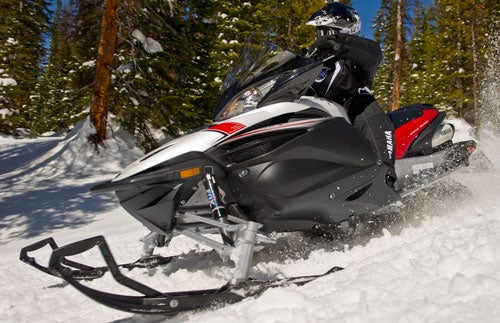 Refined ride is a direct result of how well you tune the air suspension on the 2013 Yamaha Apex SE.
Refined ride is a direct result of how well you tune the air suspension on the 2013 Yamaha Apex SE.Getting proper set up on the Apex SE begins at the beginning, when you lift the sled off the ground so that there is no weight at all on the rear suspension. You can use a winch to lift the rear bumper up to allow you to hang the suspension, or you can tip the sled on its side to unweight the track and suspension. For this initial phase we suggest lifting the rear portion of the sled with a winch or pulley system. After all, even if you placed your grandma’s softest quilt under the side of the sled, do you really want a brand new $14,000 sled resting on its side panels in your shop?
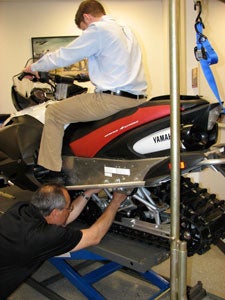 Expect further fine-tuning after you establish the base line with the rider’s weight factored in.
Expect further fine-tuning after you establish the base line with the rider’s weight factored in.Once you get the track and suspension off the shop floor, you’ll be ready to get this critical first setting underway. You’ll want to make a mark on the shock tube, perhaps with a paint pen. This mark represents a consistent reference point for all other measurements you’ll make in arriving at your set up.
From that mark on the shock tube, measure the distance between the mark and the shock body and write it down in a pocket-able notebook. Don’t worry about the number. It’s a reference.
Now you can set the sled back down, allowing the sled’s weight to compress the suspension. If you’re the primary rider, you’ll want to have an assistant help you in this set up phase, as you need to sit on the sled. To be precise you want to add in the weight of your riding gear such as helmet, boots, gloves, protective vest and snowsuit.
Once you’ve compressed the suspension with your normal gear, have your assistant re-measure the shock in the same manner. The compression should be between 32 and 38 millimeters. Within this framework, you can adjust the air pressure in the shock to set the best compression for your riding style. Obviously add pressure for a stiffer set up and bleed air out for a more compliant ride.
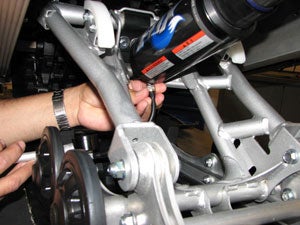 It’s relatively easy to reach the suspension’s air shock when you’re in a warm shop, adding air pressure on the trail can be more trying.
It’s relatively easy to reach the suspension’s air shock when you’re in a warm shop, adding air pressure on the trail can be more trying.Your Weather Channel app, or simply carrying one of those keychain thermometers will come in handy if you trailer a 100-miles or more away from home to a distant trailhead. Ambient temperatures will make a difference in how the air shock reacts. On the trail you can simply attach the air pump to add or remove pressure for the best ride.
Remember that notebook we mentioned? This is where you can become a bit of a statistician. You noted the original set up and the temperature at the time. On the trail you can check the adjustments based on local temperatures and a note about trail conditions in which you are riding. It won’t be long before you’ll know precisely where the pressure for your sled’s shock should be set to maximize ride in varying conditions.
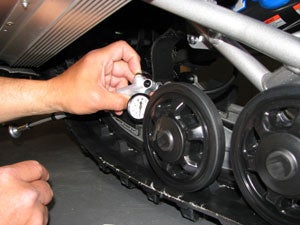 The gauge helps you set a precise air pressure for very specific ride settings.
The gauge helps you set a precise air pressure for very specific ride settings.Fortunately, over the seasons Fox and Yamaha worked together to make the current air pump more efficient and easier to use on the trail. Still, on trail pressure changes can be a bit difficult as ice typically builds up right in the area you need to get at. You might want to add a small rubber or plastic mallet to your tool kit to clear the ice – just don’t get carried away with aggression when using it.
Fortunately the front air shocks are more easily accessed to make pressure changes. We suspect that the first few times you ride the sled you’ll play with the settings to discover what works best for your riding style. It won’t be long before you’ll be a trail pro and will have settled into a few basic settings – perhaps one for aggressive bump riding, another for totally laid back compliant groomed trail rides and still another that may be an all around blend between the two.
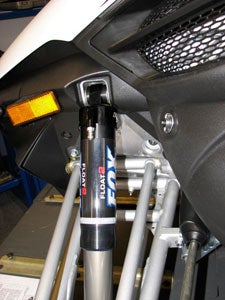 Riders will find the front air shocks with easy to reach valves are more convenient to fine tune when adding or bleeding air pressure.
Riders will find the front air shocks with easy to reach valves are more convenient to fine tune when adding or bleeding air pressure.The advantages of the air shock include simplicity and a reduction in weight, as they don’t require coil-over-shock springs. They are virtually infinitely adjustable.
But, they do require attention. Primarily that is attention to detail and consistency in set up. You may become a bit temperature obsessed as you seek the day’s best ride based on daily weather conditions.
Yamaha uses the Fox Mega Shock as it offers a huge air reservoir in comparison to the front air shock, which can make it less demanding for constant attention. While the seals are high quality all around, like any air pressure based product – tires and the like – deflation does happen and needs to be checked.
Yamaha’s air suspension requires manual adjustments. Ski-Doo uses an on-board air pump on selected top of the line touring sleds. We suspect that a partnership between air shock engineers and snowmobile suspension designers may eventually result in a much more sophisticated air-ride suspension in the future. Consider the amount of onboard computerization in sleds like Yamaha’s Apex SE, which uses computer smarts to run the EXUP exhaust valve system, the electronic power steering system and the complex controls of the electronic fuel injection. What’s the big deal about adding electronic controls on an air-ride suspension? If it happens, wed like one that reacts more quickly than the existing ones pioneered by Ski-Doo but with the near infinite adjustability of the Yamaha/Fox set up that makes it so versatile for rough or smooth trail running.
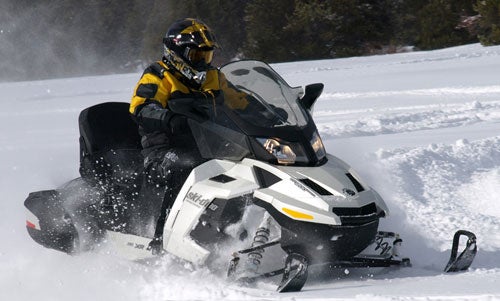 Ski-Doo’s Grand Touring “air” ride relies on an onboard air pump to set the comfort levels.
Ski-Doo’s Grand Touring “air” ride relies on an onboard air pump to set the comfort levels.For now, we have the air pump, a dab of marker to establish our base line and an eye on the Weather Channel app to help us fine tune for the temperatures of the day. That’s okay for now, but when sleds top US$20,000 we’ll expect more.
Related Reading Snowmobile Turbochargers Explained Inside Modern Snowmobile Drive Belts Track Studding the Right Way How to Install an Aftermarket Track








 Your Privacy Choices
Your Privacy Choices